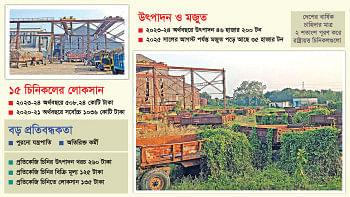Rains damage crops
Heavy rains and cyclone Komen have affected crops on 1.17 lakh hectares of land, raising risks of losses for farmers, according to the Department of Agricultural Extension or DAE.
In the southern coastal districts that recorded more rains, standing aus rice, seedbeds of aman rice and vegetables were partially damaged, DAE Director General Md Hamidur Rahman said yesterday.
The DAE estimates that 36 percent of 1.19 lakh hectares of aman seedbeds in 30 districts in the southeast and southwest regions have been submerged by rainwater and flash floods.
Noakhali and Chittagong were affected the most. Crops in Jessore and Jhenidah, two major vegetables growing districts, also suffered for the monsoon rains, which last until September in Bangladesh.
In addition, 20 percent of 87,815 hectares of vegetable fields in these districts were damaged by water logging; some 12 percent of standing aus paddy on 3.46 lakh hectares also suffered, according to the DAE.
Officials said the loss of vegetables may create a gap in production and reduce supply to the market.
Bangladesh is experiencing 25 percent more rainfall than usual this year after two consecutive dry monsoons, inundating a number of southern districts, according to the weather office.
Farmers in Bangladesh depend on the monsoon rains for irrigating summer crops including aman rice, which accounts for 38 percent of the annual rice output at 3.45 crore tonnes.
Seasonal rains swell rivers, and recharge water bodies, underground water reserves and aquifers. Poor rains force farmers to go for additional irrigation to ensure good yields. But torrential rains, like the recent ones, damage crops by causing flash foods and water logging.
The recent downpours triggered flash floods in many places in three coastal divisions -- Chittagong, Khulna and Barisal -- and caused landslides, killing at least 10 people in Bandarban and Cox's Bazar.
The DAE aims to ensure transplantation of aman on 52.6 lakh hectares this monsoon, up from 52.02 lakh hectares a year ago.
Farmers have prepared aman seedbeds on 3.39 lakh hectares, much higher than its target of 2.81 lakh hectares, to produce 1.31 crore tonnes of rice.
Of all the seedbeds prepared across Bangladesh, 13 percent went under water due to torrential rains and flash floods.
Rahman said his office closely monitors the rainfall and crop situation. Bangladesh Agricultural Development Corporation has a handsome stock of the late varieties of aman rice seeds to help farmers prepare seedbeds, he said.
"We have decided to make these seeds available to farmers in the affected regions so that they can prepare seedbeds."
Seedbeds of aman, particularly the late varieties, can be prepared until mid August, Rahman added.
"We will also ensure availability of vegetable seeds in those areas."
In addition, the agriculture ministry plans to develop buffer seedbeds of aman. "We will prepare these buffer seedbeds under government initiative to overcome the possible risks of floods after the middle of this month."
“We have an adequate stock of late varieties of aman seeds, so there would be no problem," he added.
So far, farmers have planted aman seedlings on nearly 30 percent of the area targeted by the DAE. Farmers transplanted aman on a major portion of the area in the north.

 For all latest news, follow The Daily Star's Google News channel.
For all latest news, follow The Daily Star's Google News channel. 



Comments